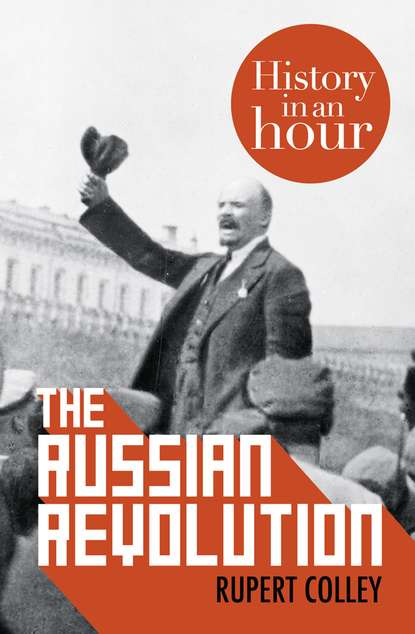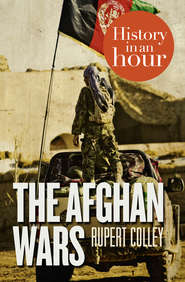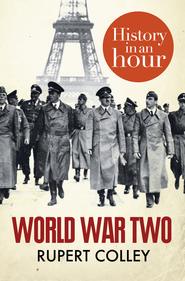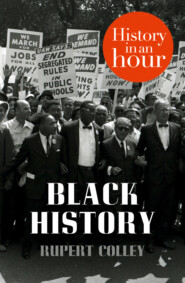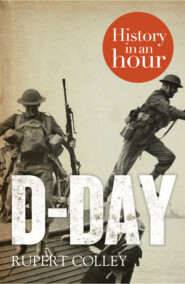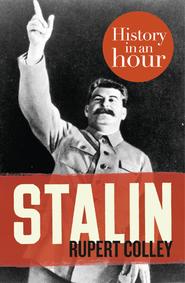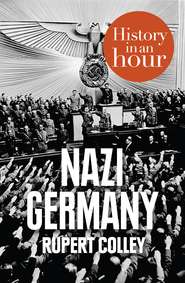По всем вопросам обращайтесь на: info@litportal.ru
(©) 2003-2024.
✖
The Russian Revolution: History in an Hour
Настройки чтения
Размер шрифта
Высота строк
Поля
The Russian Revolution: History in an Hour
Rupert Colley
Love history? Know your stuff with History in an Hour.In 1917 the world changed forever. One of the most influential and contentious events in recent history, the Russian Revolution unleashed the greatest political experiment ever conducted, one which continues to influence both Eastern and Western politics today.The Russian Revolution: History in an Hour neatly covers all the major facts and events giving you a clear and straightforward overview: from the circumstances behind the rise of Lenin and the Bolsheviks, to the consequences of their struggle for a new socialist utopia. The Russian Revolution: History in an Hour is engagingly written and accessible for all history lovers.Know your stuff: read about the Russian Revolution in just one hour.
THE RUSSIAN REVOLUTION
History in an Hour
Rupert Colley
About History in an Hour (#ulink_e8dd7ab6-0964-52ef-8a74-ed01f3a75e1d)
History in an Hour is a series of ebooks to help the reader learn the basic facts of a given subject area. Everything you need to know is presented in a straightforward narrative and in chronological order. No embedded links to divert your attention, nor a daunting book of 600 pages with a 35-page introduction. Just straight in, to the point, sixty minutes, done. Then, having absorbed the basics, you may feel inspired to explore further.
Give yourself sixty minutes and see what you can learn …
To find out more visit http://historyinanhour.com or follow us on Twitter: http://twitter.com/historyinanhour
Contents
Cover (#udf56e7ab-f131-5dfa-96b1-6f355b88bb7d)
Title Page (#u208eda1f-5abd-5a05-9c85-ba597d08f182)
About History in an Hour (#ulink_10726e0a-df98-59b3-a17a-b4d771a90081)
Introduction (#ulink_f7cddac3-f12a-586d-a8ae-256b09b897aa)
Emancipation (#ulink_f59168dc-7a60-57d8-aa72-3f5e887345a4)
Nicholas II: The Last Tsar (#ulink_7c3157ef-0986-5f5f-aa31-ad48cc3dc2bb)
The 1905 Russian Revolution (#ulink_3deebdda-c8c0-592a-9775-db2e2ae4cc13)
The October Manifesto (#ulink_99137c49-5176-55d1-86fe-b8193dc4f0e1)
War (#ulink_d4aced3b-5507-5ba8-9287-f8b2a81473e4)
February Revolution (#litres_trial_promo)
The Provisional Government (#litres_trial_promo)
The October Revolution (#litres_trial_promo)
Civil War (#litres_trial_promo)
Red Terror (#litres_trial_promo)
‘Lenin lived, Lenin lives, and Lenin will live’ (#litres_trial_promo)
Appendix 1: Key Players (#litres_trial_promo)
Appendix 2: Timeline of the Russian Revolution (#litres_trial_promo)
Copyright (#litres_trial_promo)
Got Another Hour?
About the Publisher
Note on dates
Until January 1918, Russia used the ‘Old Style’ Julian Calendar that before 1900 was 12 days behind our Gregorian calendar, and after 1900, 13 days behind. This text uses the New Style throughout.
Introduction (#ulink_40daf82e-f1a4-575b-add2-f28abdf69614)
The communist system unleashed by the Russian Revolution of 1917 was the greatest political experiment ever conducted. The Revolution promised freedom from the shackles of Imperialism, corruption and exploitation but until its collapse in 1991, the peoples of the vast Soviet empire endured seventy years of misguided socialism and totalitarianism.
The last Russian Tsar, Nicholas II, ruled over a vast empire that was backward, impoverished and in some respects largely resentful of his autocratic rule. Its people demanded reform and change. The effects of the outbreak of war in 1914 finally, in March 1917, brought down the Tsar and the 300-year-old Romanov dynasty.
The Provisional Government that replaced the Tsar proved equally ineffectual at addressing the needs of Russia’s major problems. Only the representatives of the workers, or ‘Soviets’, seemed to understand the problems that lay at the heart of the empire. From the various Soviet parties it was the Bolshevik Party and its leader, Vladimir Lenin, that seized power and established the Soviet Union with its promises of a new socialist utopia. The consequences shaped the entire twentieth century and their ramifications were felt across the world.
This, in an hour, is the Russian Revolution.
Emancipation (#ulink_d3ca446c-c480-595a-8dcf-d9cd43b1dcbb)
On 3 March 1861, Alexander II issued what seemed on the face of it the most revolutionary reform in Russia’s history – his ‘Manifesto on the Emancipation of the Serfs’. The edict freed 23 million serfs from their bondage to landowners, and wrested ownership of 85 per cent of Russia’s land from private landowners in favour of the peasants. The landlords, understandably, opposed such a sweeping change but were told by the Tsar, ‘It is better to abolish serfdom from above than to wait for the time when it will begin to abolish itself from below.’
Alexander II, c.1870
The high ideals of Alexander II’s emancipation of the serfs fell very short of its ambition. Landowners held onto 15 per cent of the land and this was, invariably, the best land; while peasants had to buy back their land from the nobles, usually at an inflated price. The majority were, inevitably, unable to afford the cost, and were offered a loan by the government, repayable at 6 per cent over forty-nine years. The peasant, freed from serfdom, was no better off and no happier.
Twenty years later, on 13 March 1881, a group calling themselves the People’s Will threw a bomb at the Tsar’s carriage in St Petersburg, fatally wounding Alexander II. The Tsar’s son (Alexander III) and twelve-year-old grandson (Nicholas II) were witness to Alexander’s violent end. As future tsars they never forgot.
Ironically, Alexander II had, just hours before his death, put his signature to a draft decree to establish a parliament, a Duma, the first step towards a constitutional monarchy. He knew that the emancipation of the serfs had failed, and that his reforms, though laudable, merely created demand for greater reform. Thus, by their very action, the terrorists had unwittingly aborted any chance of constitutional reform. Instead, they got a new Tsar, Alexander’s son, Alexander III, who immediately tore up his father’s parliamentary proposal, undid his reforms and intensified the level of repression.
The new Tsar’s Manifesto on Unshakable Autocracy, issued within two months of his father’s death, summed up Alexander III’s view on how Russia should be ruled. Liberalism and democracy were considered signs of weakness; for the benefit of all, his people needed to be ruled with a firm hand and the nation needed to be more ‘Russian’. Ethnic languages and nationalistic tendencies were repressed. The vast empire was to be subject to the Tsar’s Russification and autocratic rule.
The Tsar intended to start teaching his son the art of statesmanship once Nicholas had reached the age of thirty. But on 1 November 1894, aged only forty-nine, Alexander III died of kidney disease. His son was still only twenty-six. Following the death of his father, a fearful Nicholas was thrust unprepared into the limelight, reputedly asking, ‘what will become of me and all of Russia?’
Nicholas II: The Last Tsar (#ulink_e22ded30-f501-5512-bb7a-bf0c8829106a)
Russia in the early twentieth century was a mesh of nationalities and ethnicities – Ukrainian, Georgian, Finnish, Baltic, Armenian, German, and Polish among others. According to the Russian census of 1897, Russians themselves only constituted 44 per cent of the Tsar’s sprawling empire. This was far from a happy conglomeration of nationhood, and the Tsar needed all the mechanisms of State control to maintain command of his subjects.
Imperial Russia
Determined to follow in his father’s footsteps and rule by autocratic means, Nicholas misread the underlying discontent within the empire as the malign influence of the Jew, rather than as genuine grievance. Organizations such as the pro-tsarist Black Hundreds instituted pogroms against the Jews; their communities were forced to settle in the Western reaches of the empire, the Pale of Settlement, where their movements were curtailed.
Nicholas II, c. 1900
Rupert Colley
Love history? Know your stuff with History in an Hour.In 1917 the world changed forever. One of the most influential and contentious events in recent history, the Russian Revolution unleashed the greatest political experiment ever conducted, one which continues to influence both Eastern and Western politics today.The Russian Revolution: History in an Hour neatly covers all the major facts and events giving you a clear and straightforward overview: from the circumstances behind the rise of Lenin and the Bolsheviks, to the consequences of their struggle for a new socialist utopia. The Russian Revolution: History in an Hour is engagingly written and accessible for all history lovers.Know your stuff: read about the Russian Revolution in just one hour.
THE RUSSIAN REVOLUTION
History in an Hour
Rupert Colley
About History in an Hour (#ulink_e8dd7ab6-0964-52ef-8a74-ed01f3a75e1d)
History in an Hour is a series of ebooks to help the reader learn the basic facts of a given subject area. Everything you need to know is presented in a straightforward narrative and in chronological order. No embedded links to divert your attention, nor a daunting book of 600 pages with a 35-page introduction. Just straight in, to the point, sixty minutes, done. Then, having absorbed the basics, you may feel inspired to explore further.
Give yourself sixty minutes and see what you can learn …
To find out more visit http://historyinanhour.com or follow us on Twitter: http://twitter.com/historyinanhour
Contents
Cover (#udf56e7ab-f131-5dfa-96b1-6f355b88bb7d)
Title Page (#u208eda1f-5abd-5a05-9c85-ba597d08f182)
About History in an Hour (#ulink_10726e0a-df98-59b3-a17a-b4d771a90081)
Introduction (#ulink_f7cddac3-f12a-586d-a8ae-256b09b897aa)
Emancipation (#ulink_f59168dc-7a60-57d8-aa72-3f5e887345a4)
Nicholas II: The Last Tsar (#ulink_7c3157ef-0986-5f5f-aa31-ad48cc3dc2bb)
The 1905 Russian Revolution (#ulink_3deebdda-c8c0-592a-9775-db2e2ae4cc13)
The October Manifesto (#ulink_99137c49-5176-55d1-86fe-b8193dc4f0e1)
War (#ulink_d4aced3b-5507-5ba8-9287-f8b2a81473e4)
February Revolution (#litres_trial_promo)
The Provisional Government (#litres_trial_promo)
The October Revolution (#litres_trial_promo)
Civil War (#litres_trial_promo)
Red Terror (#litres_trial_promo)
‘Lenin lived, Lenin lives, and Lenin will live’ (#litres_trial_promo)
Appendix 1: Key Players (#litres_trial_promo)
Appendix 2: Timeline of the Russian Revolution (#litres_trial_promo)
Copyright (#litres_trial_promo)
Got Another Hour?
About the Publisher
Note on dates
Until January 1918, Russia used the ‘Old Style’ Julian Calendar that before 1900 was 12 days behind our Gregorian calendar, and after 1900, 13 days behind. This text uses the New Style throughout.
Introduction (#ulink_40daf82e-f1a4-575b-add2-f28abdf69614)
The communist system unleashed by the Russian Revolution of 1917 was the greatest political experiment ever conducted. The Revolution promised freedom from the shackles of Imperialism, corruption and exploitation but until its collapse in 1991, the peoples of the vast Soviet empire endured seventy years of misguided socialism and totalitarianism.
The last Russian Tsar, Nicholas II, ruled over a vast empire that was backward, impoverished and in some respects largely resentful of his autocratic rule. Its people demanded reform and change. The effects of the outbreak of war in 1914 finally, in March 1917, brought down the Tsar and the 300-year-old Romanov dynasty.
The Provisional Government that replaced the Tsar proved equally ineffectual at addressing the needs of Russia’s major problems. Only the representatives of the workers, or ‘Soviets’, seemed to understand the problems that lay at the heart of the empire. From the various Soviet parties it was the Bolshevik Party and its leader, Vladimir Lenin, that seized power and established the Soviet Union with its promises of a new socialist utopia. The consequences shaped the entire twentieth century and their ramifications were felt across the world.
This, in an hour, is the Russian Revolution.
Emancipation (#ulink_d3ca446c-c480-595a-8dcf-d9cd43b1dcbb)
On 3 March 1861, Alexander II issued what seemed on the face of it the most revolutionary reform in Russia’s history – his ‘Manifesto on the Emancipation of the Serfs’. The edict freed 23 million serfs from their bondage to landowners, and wrested ownership of 85 per cent of Russia’s land from private landowners in favour of the peasants. The landlords, understandably, opposed such a sweeping change but were told by the Tsar, ‘It is better to abolish serfdom from above than to wait for the time when it will begin to abolish itself from below.’
Alexander II, c.1870
The high ideals of Alexander II’s emancipation of the serfs fell very short of its ambition. Landowners held onto 15 per cent of the land and this was, invariably, the best land; while peasants had to buy back their land from the nobles, usually at an inflated price. The majority were, inevitably, unable to afford the cost, and were offered a loan by the government, repayable at 6 per cent over forty-nine years. The peasant, freed from serfdom, was no better off and no happier.
Twenty years later, on 13 March 1881, a group calling themselves the People’s Will threw a bomb at the Tsar’s carriage in St Petersburg, fatally wounding Alexander II. The Tsar’s son (Alexander III) and twelve-year-old grandson (Nicholas II) were witness to Alexander’s violent end. As future tsars they never forgot.
Ironically, Alexander II had, just hours before his death, put his signature to a draft decree to establish a parliament, a Duma, the first step towards a constitutional monarchy. He knew that the emancipation of the serfs had failed, and that his reforms, though laudable, merely created demand for greater reform. Thus, by their very action, the terrorists had unwittingly aborted any chance of constitutional reform. Instead, they got a new Tsar, Alexander’s son, Alexander III, who immediately tore up his father’s parliamentary proposal, undid his reforms and intensified the level of repression.
The new Tsar’s Manifesto on Unshakable Autocracy, issued within two months of his father’s death, summed up Alexander III’s view on how Russia should be ruled. Liberalism and democracy were considered signs of weakness; for the benefit of all, his people needed to be ruled with a firm hand and the nation needed to be more ‘Russian’. Ethnic languages and nationalistic tendencies were repressed. The vast empire was to be subject to the Tsar’s Russification and autocratic rule.
The Tsar intended to start teaching his son the art of statesmanship once Nicholas had reached the age of thirty. But on 1 November 1894, aged only forty-nine, Alexander III died of kidney disease. His son was still only twenty-six. Following the death of his father, a fearful Nicholas was thrust unprepared into the limelight, reputedly asking, ‘what will become of me and all of Russia?’
Nicholas II: The Last Tsar (#ulink_e22ded30-f501-5512-bb7a-bf0c8829106a)
Russia in the early twentieth century was a mesh of nationalities and ethnicities – Ukrainian, Georgian, Finnish, Baltic, Armenian, German, and Polish among others. According to the Russian census of 1897, Russians themselves only constituted 44 per cent of the Tsar’s sprawling empire. This was far from a happy conglomeration of nationhood, and the Tsar needed all the mechanisms of State control to maintain command of his subjects.
Imperial Russia
Determined to follow in his father’s footsteps and rule by autocratic means, Nicholas misread the underlying discontent within the empire as the malign influence of the Jew, rather than as genuine grievance. Organizations such as the pro-tsarist Black Hundreds instituted pogroms against the Jews; their communities were forced to settle in the Western reaches of the empire, the Pale of Settlement, where their movements were curtailed.
Nicholas II, c. 1900





